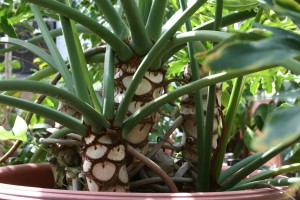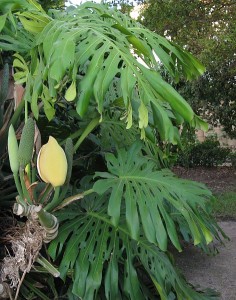Philodendron bipinnatifidum

Phildodendron bipinnatifidum is a common landscape plant in much of the southern United States and it is admired for its large leaves and spreading form as well as its ability to form aerial roots. It is not its beauty or uniqueness that is most interesting though. The most interesting aspect of P. bipinnatifidum, and most of the plants in the Aroid family (Araceae), is its reproduction process.

Philodendron bipinnatifidum relies on nocturnal beetles of the genus Cyclocephala for pollination. These beetles are attracted to chemicals that the flowers produce, and by warming the flowers the release of these chemicals is enhanced. As the beetles draw nearer to the source they are able to find the flowers easily due to the heat that is emitted from them. The heat generated by the flowers now serves a new purpose. As beetles land on the flowers they eat some of the pollen, but much of it becomes stuck to their bodies, which will pollinate the next plant. After feeding, the beetles spend the rest of the night and the following day inside the spathe. It is believed that by spending the night near these warm flowers the beetles conserve a great amount of energy, which allows them to more readily fly to the next flower the following evening and continue the process of pollination.
[1] Miller, R., N. Grant, L. Giles, M. Ribas-Carbo, J. Berry, J. Watling & S. Robinson. (2010) In the heat of the night – alternative pathway respiration drives thermogenesis in Philodendron bipinnatifidum. New Phytologist 189:1013-1026.
